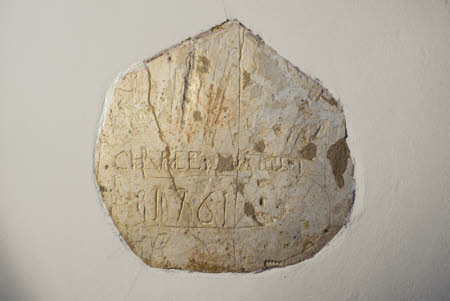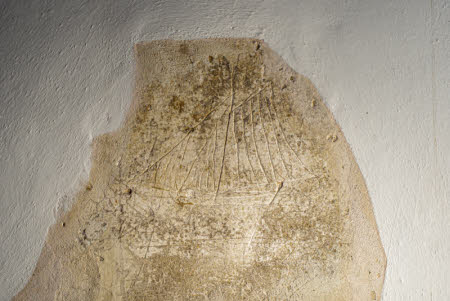Graffiti
Category
Architecture / Features & Decoration
Date
1750 - 1760
Materials
Order this imageCollection
Sissinghurst Castle Garden, Kent
NT 803649
Caption
Graffiti depicting a ship in full sail was scratched into the wall of the tower at Sissinghurst sometime during the Seven Years War (1756–63). This violent power struggle between France and nations across Europe and the globe saw many men captured and imprisoned. It is believed that up to 3,000 French prisoners were incarcerated at Sissinghurst, some of whom literally left their mark on its history. As well as ships, names and dates were found etched into the soft stone during conservation work in 2018, a tangible link to the men held here against their will. Little is known about the individuals who created these graffiti, but the tower generally housed French naval officers. Overcrowding and brutal punishments meant that Sissinghurst was considered one of the worst military prisons in the country. A painting from the time, thought to be by an inmate, shows red-coated English guards attacking the prisoners. Letters written by the imprisoned seamen to their families described the prison as ‘Chateau de Sissinghurst’, one reason the house is known today as Sissinghurst Castle.
Summary
Graffiti by French prisoners of war.
Full description
During preparations for conservation work in 2018, archaeologists from the National Trust and Museum of London Archaeology (MOLA) were able to undertake detailed examinations of the walls of the Elizabethan tower at Sissinghurst. The collection of drawings on the soft tower walls were captured in archaeological surveys, which recorded depictions of ships in full sail, etchings of large sailing vessels and names thought to be of prisoners held at Sissinghurst. Some 18 previously unknown drawings were found by the archaeologists, although it is believed more may have been lost over the years due to the fragile nature of the stone and plaster surfaces on which they were originally drawn. Records suggest as many as 3,000 men were imprisoned at Sissinghurst in the early 1760s, when the house was leased to the government for use as a prison. Many of the imprisoned French seamen wrote letters home. Some are now held by the National Archives and describe Sissinghurst as ‘Chateau de Sissinghurst’, a reason the house is today called Sissinghurst Castle. A contemporary ink and paper painting of Sissinghurst, possibly by an inmate, depicts prisoners being attacked by the red-coated English guards (see NT 2900001). Surviving petitions from prisoners and investigation reports reveal the poor treatment and squalid conditions they endured.

